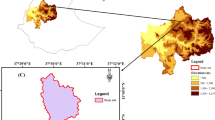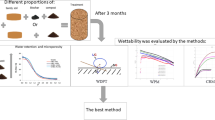Abstract
In a previous study, remediation of anthracene from soil was faster in the top 0–2 cm layer than in the lower soil layers. It was not clear whether this faster decrease was due to biotic or abiotic processes. Anthracene-contaminated soil columns were covered with black or transparent perforated polyethylene so that aeration occurred but that fluctuations in water content were minimal and light could reach (LIGHT treatment) or not reach the soil surface (DARK treatment), or left uncovered so that soil water content fluctuate and light reached the soil surface (OPEN treatment). The amount of anthracene, microbial biomass C, and microbial activity as reflected by the amount of CO2 produced within 3 days were determined in the 0–2 cm, 2–8 cm, and 8–15 cm layer after 0, 3, 7, 14, and 28 days. In the 0–2 cm layer of the OPEN treatment, 17% anthracene remained, 48% in the LIGHT treatment and 61% in the DARK treatment after 28 days. In the 2–8 cm and 8–15 cm layer, treatment had no significant effect on the dissipation of anthracene from soil after 14 and 28 days. It was found that light and fluctuations in water content stimulated the removal of anthracene from the top 0–2 cm soil layer, but not from the lower soil layers. It can be speculated that covering contaminated soil or pilling it up will inhibit the dissipation of the contaminant.

Similar content being viewed by others
References
Amato M (1983) Determination of 12C and 14C in plant and soil. Soil Biol Biochem 15:611–612. doi:10.1016/0038-0717(83)90059-7
Anderson JP, Domsch KH (1978) Mineralization of bacteria and fungi in chloroform-fumigated soils. Soil Biol Biochem 10:207–213. doi:10.1016/0038-0717(78)90098-6
Atagana HI, Haynes RJ, Wallis FM (2003) Optimization of soil physical and chemical conditions for the bioremediation of creosote-contaminated soil. Biodegradation 14:297–307. doi:10.1023/A:1024730722751
Bertilsson S, Widenfalk A (2004) Photochemical degradation of PAHs in freshwater and their impact on bacterial growth—influence of water chemistry. Hydrobiology 469:23–32. doi:10.1023/A:1015579628189
Betancur-Galvis LA (2005) Evaluación de la fitorremdiacion con Athel tamarix (Tamarix aphylla) y de la bioestimulación por fertilizantes en suelos salino-alcailnos del exlago de Texcoco contaminados con hidrocarburos aromáticos. PhD Thesis, Cinvestav, Mexico
Betancur-Galvis LA, Alvarez-Bernal D, Ramos-Valdivia AC, Dendooven L (2006) Bioremediation of polycyclic aromatic hydrocarbon-contaminates saline-alkaline soil of the former Lake Texcoco. Chemosphere 62:1749–1760. doi:10.1016/j.chemosphere.2005.07.026
Brady NC, Weil RR (1999) The nature and properties of soils. Prentice Hall, Upper Saddle River, New Jersey 07458
Bremner JM (1996) Total nitrogen. In: Sparks DL (ed) Methods of soil analysis, part 3 chemical methods. Soil Science Society of America Inc, American Society of Agronomy, Madison, WI, USA, pp 1085–1122
Feng XJ, Nielsen LL, Simpson MJ (2007) Responses of soil organic matter and microorganisms to reeze-thaw cycles. Soil Biol Biochem 39:2027–2037. doi:10.1016/j.soilbio.2007.03.003
Ford DJ, Cookson WR, Adams MA, Grierson PF (2007) Role of soil drying in nitrogen mineralization and microbial community function in semi-arid grasslands of north-west Australia. Soil Biol Biochem 39:1557–1569. doi:10.1016/j.soilbio.2007.01.014
Gee GW, Bauder JW (1986) Particle size analysis. In: Klute A (ed) Methods of soil analysis, part 1 physical and mineralogical methods. Soil Science Society of America Inc, American Society of Agronomy, Madison, WI, USA, pp 383–411
Grant RJ, Muckian LM, Clipson NJW, Doyle EM (2007) Microbial community changes during the bioremediation of creosote-contaminated soil. Lett Appl Microbiol 44:293–300. doi:10.1111/j.1472-765X.2006.02066.x
Jenkinson DS, Powlson DS (1976) The effects of biocidal treatments on metabolism in soil. V. A method for measuring soil biomass. Soil Biol Biochem 8:209–213. doi:10.1016/0038-0717(76)90005-5
Johnsen RA, Wick YL, Harms H (2004) Principles of microbial PAH-degradation in soil. Environ Pollut 133:71–84. doi:10.1016/j.envpol.2004.04.015
Kalbitz K, Solinger S, Park J-H, Michalzik B, Matzner E (2000) Controls on the dynamics of dissolved organic matter in soils: a review. Soil Sci 165:277–304. doi:10.1097/00010694-200004000-00001
Kästner M, Streibich S, Beyrer M, Richnow HH, Frietsche W (1999) Formation of boun residues during microbial degradation of [14C] anthracene in soil. Appl Environ Microbiol 65:1834–1842
Kieft LT, Soroker E, Firestone MK (1987) Microbial biomass response to a rapid increase in water potential when dry soil is wetted. Soil Biol Biochem 19:119–126. doi:10.1016/0038-0717(87)90070-8
Leahy JG, Colwell RR (1990) Microbial degradation of hydrocarbons in the environment. Microbiol Mol Biol Rev 54:305–315
Lund V, Goksøyr J (1980) Effects of water on microbial mass and activity in soil. Microb Ecol 6:115–123. doi:10.1007/BF02010550
Mahmood SK, Rao PR (1993) Microbial abundance and degradation of polycyclic aromatic hydrocarbons in soil. Bull Environ Contam Toxicol 50:486–491. doi:10.1007/BF00191235
Margesin R, Zimmerbauer A, Schinner F (2000) Monitoring of bioremediation by soil biological activities. Chemosphere 40:339–346
Mcnally DL, Mihelcic JR, Lueking DR (1998) Biodegradation of three- and four-ring polycyclic aromatic hydrocarbons under aerobic and denitrifying conditions. Environ Sci Technol 32:2633–2639. doi:10.1021/es980006c
Morgan P, Watkinson RJ (1990) Hydrocarbon degradation in soil and methods for soil biotreatment. Crit Rev Biotechnol 8:305–333. doi:10.3109/07388558909148196
Mueller KE, Shann JR (2006) PAH dissipation in spiked soil: impacts of bioavailability, microbial activity, and trees. Chemosphere 64:1006–1014. doi:10.1016/j.chemosphere.2005.12.051
Muszkat L, Halamann M, Raucherd D, Bir L (1992) Solar photodegradation of xenobiotic contaminants in polluted well water. J Photoch Photobio Chem (Kyoto) 65:409–417
Nam K, Alexander M (2001) Relationship between biodegradation rate and percentage of a compound that becomes sequestered in soil. Soil Biol Biochem 33:787–792. doi:10.1016/S0038-0717(00)00226-1
Reichenberg F, Mayer P (2006) Two complementary sides of bioavailability: accessibility and chemical activity of organic contaminants in sediments and soils. Environ Toxicol Chem 25:1239–1245. doi:10.1897/05-458R.1
Riser-Roberts E (1998) Remediation of petroleum contaminated soils: biological, physical and chemical processes. Lewis Publishers, Washington, DC
SAS Institute (1989) Statistic guide for personal computers version 604. SAS Institute, Cary, NC
Song YF, Ou ZQ, Sun TH, Yediler A, Lorinci G, Kettrup A (1995) Analytical method for polycyclic aromatic hydrocarbons (PAHs) in soil and plants samples. Chin J Appl Ecol 6:92–96
Straube WL, Nestler CC, Hansen LD, Rindgleberg D, Pritchard PH, Jones-Meehan J (2003) Remediation of polyaromatic hydrocarbons (PAHs) through landfarming with biostimulation and bioaugmentation. Acta Biotechnol 23:179–196. doi:10.1002/abio.200390025
Thomas GW (1996) Soil pH and soil acidity. In: Sparks DL (ed) Methods of soil analysis, part 3 chemical methods. Soil Science Society of America Inc, American Society of Agronomy, Madison, WI, USA, pp 475–490
Utomo WH, Dexter AR (1982) Changes in soil aggregate water stability induced by wetting and drying cycles in non-saturated soil. Soil Sci 4:623–637
Van Veen JA, Kuikman PJ (1990) Soil structural aspects of decomposition of organic matter by micro-organisms. Biodegradation 3:213–233
Volkering F, Breure AM (1997) Microbiological aspects of surfactant use for biological soil remediation. Biodegradation 8:401–417. doi:10.1023/A:1008291130109
Wilson SC, Jones KC (1993) Bioremediation of soil contaminated with polynuclear aromatic hydrocarbons (PAHs): a review. Environ Pollut 81:229–249. doi:10.1016/0269-7491(93)90206-4
Winding A, Binnerup JS, Sorensen J (1994) Viability of indigenous soil bacteria assayed by respiratory activity and growth. Appl Environ Microbiol 60:2869–2875
Acknowledgments
E. V.-N. received grant-aided support from ‘Consejo Nacional de Ciencia y Tecnología’ (CONACyT, México). The research was funded by CONACyT project 39801-Z and ‘Secretaria de Medio Ambiente y Recursos Naturales’ (SEMARNAT, Mexico) project 2002-C01-0054.
Author information
Authors and Affiliations
Corresponding author
Rights and permissions
About this article
Cite this article
Vázquez Núñez, E., García Gaytán, A., Luna-Guido, M. et al. Impact of moisture dynamic and sun light on anthracene removal from soil. Biodegradation 20, 191–198 (2009). https://doi.org/10.1007/s10532-008-9212-4
Received:
Accepted:
Published:
Issue Date:
DOI: https://doi.org/10.1007/s10532-008-9212-4




